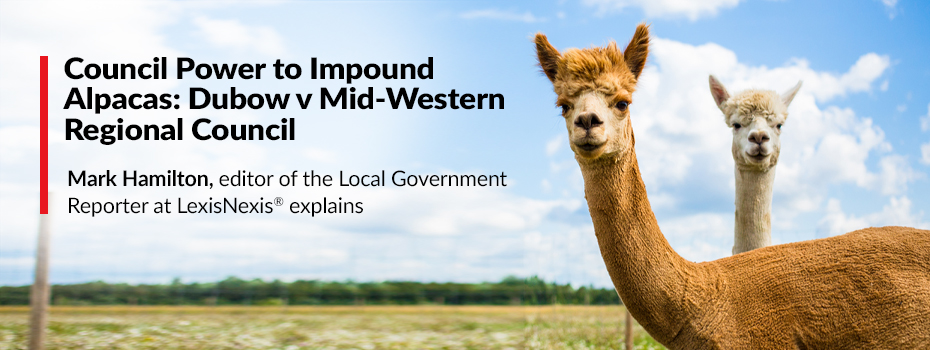
Council Power to Impound Alpacas: Dubow v Mid-Western Regional Council
23 September 2022 12:03
Mark Hamilton COMMISSIONING EDITOR
On 02 May 2019, Council officers from Mid-Western Regional Council (Council), upon finding seven of the Applicant’s alpacas unattended on a public road, impounded (and later sold) those animals, purporting to exercise authority under s 116(3) of the Local Land Services Act 2013 (NSW) (LLS Act).[1] A further three alpacas were impounded on 18 February 2020.[2] Notwithstanding a substantial litigation history,[3] the essence of the application for leave to appeal before the New South Wales Court of Appeal can be distilled into three proposed grounds of appeal:
- Whether the Council is an "impounding authority" within the meaning of the LLS Act;[4]
- Whether alpacas are "stock" or "animals" within the meaning of the Impounding Act 1993 (NSW);[5]
- Whether the alpacas were sold at a public auction.[6]
The Applicant also sought leave to appeal an interlocutory decision relating to a notice to produce, and a costs order made against the Applicant in the sum of $70,000.[7] Commentary is not provided on these matters in this article.
Impounding authority
The Council officers identified their source of authority as s 116(3) of the LLS Act which provides:
An impounding officer may impound any stock the impounding officer suspects to be on a public road, travelling stock reserve or other public land in contravention of this section in the same way that the impounding officer may impound an animal under section 9 of the Impounding Act 1993 [(NSW)].[8]
The Dictionary to the Impounding Act defines "impounding authority" to include a "council", with "council" itself defined to mean a council under the Local Government Act 1993 (NSW). The Court of Appeal held that there was no dispute that Mid-Western Regional Council is a council under the Local Government Act.[9]
The primary judge held that the definition of "impounding officer" in the Impounding Act provides the relevant authority to the Council officers; an "impounding officer" being "a person appointed by an impounding authority to exercise the powers of an impounding officer". The Applicant challenged this conclusion by relying on the definition of "authorising authority" under the LLS Act. The submission being that the Council is not an authorising authority under that Act. The Court of Appeal described this challenge as "misconceived", reasoning that even if the Council is not an "authorising authority" under the LLS Act, s 116(3) of that same Act confers power on an "impounding officer" which is appointed by an "impounding authority" (of which Council is) and not an "authorising authority".[10]
Alpaca; animal or stock?
The Applicant argued that alpacas are not "animals" under the Impounding Act. The Court of Appeal stated that even if that was true, the power to impound under s 116(3) of the LLS Act relates to "stock". The Dictionary to that Act includes alpacas within the definition of "stock".[11] There was no error in the primary judge concluding that alpacas were stock for the purposes of s 116(3) of the LLS Act, and any argument that this was in error was not tenable.
Were the alpacas sold at a public auction?
Under s 24(1) of the Impounding Act, the Council must cause the alpacas to be offered for sale if not released before the deadline for release (as defined in subsection (5)). The sale is to be by public auction or public tender.[12] The primary judge had reasoned that the sale was by "public" auction notwithstanding the fact that the Applicant did not:
[60] ... belong to the class of prospective purchasers: she was entitled to have the alpacas returned to her as long as she paid any outstanding fees associated with the impounding and holding of the alpacas. At no time was she prepared to pay the outstanding fees. In these circumstances, her exclusion from the public auction did not render it any less a public auction.[13]
The Court of Appeal concluded that the Applicant offered no argument to support the correctness of the primary judge’s conclusions on this aspect. Based on the findings made in relation to these three matters, the Court of Appeal reasoned that there was no basis to grant leave to the Applicant to appeal with respect to the principal judgment.[14]
This is an interesting case and definitely relevant to local council because it showcases the authority of a council to impound stock under the LLS Act, and by necessary implication the Impounding Act.
 | Mark Hamilton Commissioning Editor |
[1]Dubow v Mid-Western Regional Council (No 3) [2021] NSWCA 279; BC202111210; at [6].
[2] Above,at [6]-[7].
[3] The history of the matter includes dismissal, for want of jurisdiction, of applications to the Administrative and Equal Opportunity Division of the New South Wales Civil and Administrative Tribunal seeking administrative review of the Council impounding of the alpaca (Dubow v Mid-Western Regional Council [2019] NSWCATAD 142); dismissal by the New South Wales Civil and Administrative Tribunal Appeal Panel of an appeal against the decision made in [2019] NSWCATAD 142 (Dubow v Mid-Western Regional Council [2019] NSWCATAP 242); dismissal of a summons filed in the New South Wales Supreme Court seeking judicial review of the Council’s actions in impounding and selling the Applicant’s alpacas. In those proceedings, a costs order was made against the Applicant (Dubow v Mid-Western Regional Council [2021] NSWSC 767); dismissal of an appeal made by the Applicant against the costs order made against them in the Supreme Court (Dubow v Mid-Western Regional Council [2021] NSWSC 767; BC202105501).
[4] Above, n 1 at [9]–[12].
[5] Above, n 1 at [13]–[14].
[6] Above, n 1 at [15]–[16].
[7] Above, n 1 at [2].
[8] Section 9(1) of the Impounding Act provides that "[a]n impounding officer may impound an animal that is in a public place in the area of operations of the officer if the officer believes on reasonable grounds that the animal is unattended". Section 9(2) of that same Act provides instances when an "an animal is not to be regarded as being unattended for the purposes of this section…"
[9] Above, n 1 at [11].
[10] Above, n 1 at [12].
[11]Above, n 1 at [13].
[12] Section 24(5) of the Impounding Act provides that a "deadline for release" for an impounded item is— (a) in the case of an impounded animal--7 days from the day on which notice was given to the owner of the animal under section 20 or, if reasonable inquiries by the impounding authority concerned have failed to reveal the name and address of the owner, 7 days from the day on which those inquiries were completed, or (b) in the case of an impounded article—28 days from the day on which notice was given to the owner of the item under section 20 or, if reasonable inquiries have failed to reveal the name and address of the owner, 28 days from the day on which those inquiries were completed or the date on which the article was impounded (whichever is the later)’.
[13] Above, n 1 at [15].
[14] Above, n 1 at [16].
Related Articles
-
 Thousands of measures are proposed across Australia annually, and hundreds end up being legislated, ranging from relatively minor, to wide-ranging policy that can have major social, economic, or industrial significance.
Thousands of measures are proposed across Australia annually, and hundreds end up being legislated, ranging from relatively minor, to wide-ranging policy that can have major social, economic, or industrial significance. -
 If the wind of change a new Government typically carries failed to create a buzz in Australia’s new Parliament, a diverse crossbench, in both the Lower and Upper Houses, and invigorated public discourse, certainly will.
If the wind of change a new Government typically carries failed to create a buzz in Australia’s new Parliament, a diverse crossbench, in both the Lower and Upper Houses, and invigorated public discourse, certainly will. -
 Those faced with leading organisations in current volatile environments clearly encounter significant challenges. Effective leaders are those who have the skills to make good decisions in an ambiguous environment, develop opportunities through innovation to gain a competitive advantage. They are highly valuable to organisations.
Those faced with leading organisations in current volatile environments clearly encounter significant challenges. Effective leaders are those who have the skills to make good decisions in an ambiguous environment, develop opportunities through innovation to gain a competitive advantage. They are highly valuable to organisations.
 LexisNexis
LexisNexis